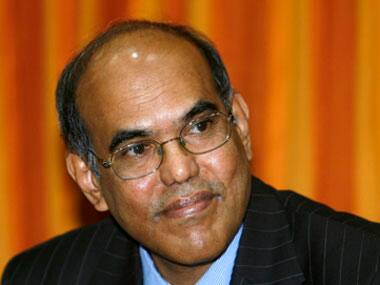A day before its much awaited first quarter review of its Annual Policy 2013-2014, the Reserve Bank of India’s macroeconomic and monetary developments review has pointed to a slew of risks facing the economy, giving little signal that any relief was round the corner for an embattled economy witnessing a marked deceleration in industrial production and growth.
RBI’s macro review for the first quarter is a signal that the central bank will likely keep rates on hold and maintain status quo on 30 July, now that it has tightened liquidity sharply over two stages, a move that has hit the corporate sector and banks hard and is seen as a threat to growth. Having undertaken those liquidity tightening measures to stem a rapidly sliding rupee, RBI is likely to adopt a wait-and-watch approach on policy review day, rather than top it up with any further action on rates or the cash reserve ratio (CRR).
[caption id=“attachment_994717” align=“alignright” width=“380”]  By all accounts, this time too, Chidambaram may have to walk alone as Subbarao continues to battle risks to the rupee and to inflation. Reuters[/caption]
The RBI sees the liquidity tightening as a “recalibrating” of policy with a view to restoring stability in the foreign exchange market. In two major moves earlier this month, RBI raised the marginal standing facility and the bank rate and capped banks’ access to borrowing under the liquidity adjustment facility. It also stipulated higher daily maintenance of CRR and undertook open market sales of government bonds.
In a rather hawkish review of the macroeconomic scenario, the RBI sent out clear signals that, for now, managing the rupee will be its clear priority. Pushing growth, something Finance Minister Palaniappan Chidambaram is hoping the RBI will once again focus on, seems to be a lesser priority for the central bank right now.
In fact, RBI even says its liquidity tightening moves to contain the rupee’s decline were only to provide a temporary breather. “Recent liquidity tightening measures taken by the Reserve Bank to curb volatility in the exchange rate provide, at best, some breathing time. This strategy will succeed if reinforced by structural reforms to reduce the current account deficit (CAD) and step up savings and investment,” the central bank said in its macro review. The signal: the ball is back in the government’s court.
There are several problem areas which the review highlights. For one, global economic conditions will remain under severe stress owing to uncertainty surrounding the tapering off of the US’s quantitative easing (QE) program. “Global financial markets have entered into a period of fresh turbulence, with re-pricing of risks from likely tapering of quantitative easing. Going forward, interest rates could continue to harden and financial conditions could tighten further, keeping markets episodically under stress,“RBI says.
The second point, a factor RBI had earlier referred to as a major challenge, is the current account deficit (CAD). Here too, the central bank does not have any optimism to share.
Even though the current account deficit (CAD) to GDP ratio moderated to 3.8 per cent in Q4 of 2012-13 from its historic high of 6.5 per cent in Q3 of 2012-13, indications are that it may have widened again in Q1 of 2013-14, the review says. Trade deficit has widened in Q1 of 2013-14 on account of contraction in exports and sharp increase in gold imports. Going forward, the current account is expected to show improvement. The demand for gold is likely to decline with increase in customs duty and rationalisation of gold import policy.
However, RBI says while CAD may fall in 2013-14, “risks to CAD financing have increased with firming up of US yields that caused global bond sell off and capital outflows from EMDEs, including India.”
RBI, of course, recognizes that growth and industrial activity and investment are seriously under stress. It says professional forecast outside RBI have lowered the growth projection to a modest recovery of 5.7 percent, which is lower than the May projection of 6 percent. Headline inflation too, however, is projected lower than earlier at 5.3 percent, against the earlier 6.5 percent in May.
But despite the lower wholesale price inflation (WPI) projection, RBI’s stance remains hawkish on inflation as well. The central bank says while a moderation in global commodity prices, a negative output gap and monetary policy actions have led to a softening of headline inflation, even on that front upside risks have increased. The recent rupee depreciation and the hike in fuel prices have once again increased the upside risks to WPI inflation, warns RBI in the review.
RBI governor Duvvuri Subbarao, who demits office on September 5, will be hard pressed to agree with Chidambaram, who said RBI also needs to promote growth, not just rein in inflation, even as RBI unveiled its macro review the same day.
By all accounts, this time too, Chidambaram may have to walk alone as Subbarao continues to battle risks to the rupee and to inflation. 30 July holds the key.


)
)
)
)
)
)
)
)
)



